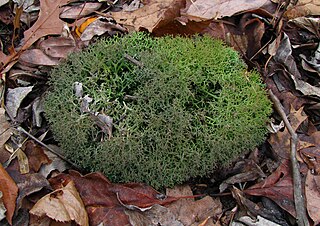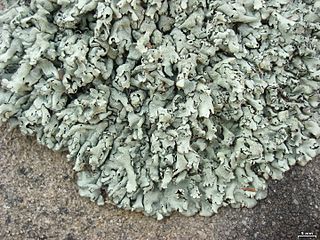
Lobaria is a genus of foliose lichens, formerly classified in the family Lobariaceae, but now placed in the Peltigeraceae. They are commonly known as "lung wort" or "lungmoss" as their physical shape somewhat resembles a lung, and their ecological niche is similar to that of moss.

Cladonia furcata or the many-forked cup lichen is a species cup lichen in the family Cladoniaceae. It has an intermediate to tolerant air pollution sensitivity. Extracts of this species have been shown to kill leukemia cells in vitro, and may have possible value in the treatment of cancer.

Hypogymnia is a genus of foliose lichens in the family Parmeliaceae. They are commonly known as tube lichens, bone lichens, or pillow lichens. Most species lack rhizines that are otherwise common in members of the Parmeliaceae, and have swollen lobes that are usually hollow. The lichens usually grow on the bark and wood of coniferous trees.

Ophioparma is a genus of crustose lichens in the family Ophioparmaceae.

Anzia is a genus of foliose lichens known as black-foam lichens in the large family Parmeliaceae. It was formerly included in the monogeneric family Anziaceae, but this has since been subsumed into the Parmeliaceae.

Bryoria is a genus of lichenized fungi in the family Parmeliaceae. Many members of this genus are known as horsehair lichens. The genus has a widespread distribution, especially in boreal and cool temperate areas.

Oxneria fallax, also known as the hooded sunburst lichen, is a small yellow-orange to red-orange foliose lichen that grows on bark or rarely on rock or bone. It is found all over the world except very dry areas, with 10 species common in North America. The nonfruiting body (thallus) grows in rosettes to 3
Bryoria hengduanensis is a species of lichen of the genus Bryoria. It was described as new to science in 2003 by lichenologists Li-Song Wang and Hiroshi Harada. It is found in the Hengduan Mountains of southern China, where it grows on twigs and branches in coniferous forests at elevations of 3,000–4,000 metres (9,800–13,100 ft). The Hengduan Mountains is a region of high Bryoria biodiversity, as 24 species are known from this area.

Hypogymnia occidentalis, commonly known as the lattice tube lichen, is a species of foliose lichen in the family Parmeliaceae. It is found in North America, where it grows on the lower trunks of conifers, particularly Douglas-fir.
Bruce Pettit McCune is an American lichenologist, botanist, plant ecologist, and software developer for analysis of ecological data.
Hypogymnia laxa is a species of foliose lichen in the family Parmeliaceae. Found in the Chinese Himalayas, it was described as a new species by Bruce McCune in 2003. The type specimen was collected from the Jiaozi Snow Mountain in Luquan County (Yunnan), at an elevation of 3,750 metres (12,300 ft). Here it was found growing on the bark and wood of Abies, Pinus, and Rhododendron. The lichen is characterized by a thallus with soredia, the presence of physodalic acid in the medulla, and rimmed holes on the lower surface. This latter feature distinguishes it from the morphologically similar Hypogymnia pseudophysodes, which always has unrimmed holes.
Hypogymnia pseudocyphellata is a rare species of foliose lichen in the family Parmeliaceae. Found only in the Chinese Himalayas, it was described as a new species by Bruce McCune and Erin Martin in 2003. The type specimen was collected from the Tian Chi alpine lake in Shangri-La City (Yunnan), at an elevation of 3,750 metres (12,300 ft). Here it was found growing on the bark and wood of fir. The lichen is characterized by the presence of whitish pseudocyphellae on the tips of the lobes ; rimmed holes; lobes that are narrow and separated; and a complex secondary chemistry with several unknown chemical compounds as well as barbatic acid, but without diffractaic acid.
Hypogymnia diffractaica is a species of foliose lichen in the family Parmeliaceae. Initially reported from Southwest China, it was described as a new species by Bruce McCune in 2003. The type specimen was collected in Jiulong County, at an elevation of 3,000 metres (9,800 ft). Here it was found growing on the bark and wood of Rhododendron; it has also been recorded on birch. It is characterized by its slender lobes, the rimmed holes on the lower surface, and the presence of the chemical diffractaic acid as the main secondary metabolite in the medulla. It has a lower surface that is expanded and puffed out. Hypogymnia hengduanensis, the only other Hypogymnia species containing diffractaic acid as the main medullary substance, is quite similar in appearance, but can be distinguished from H. diffractaica by the presence of isidia. It also tends to grow at slightly lower elevations. In 2018, H. diffractaica was recorded from Bhutan.
Hypogymnia congesta is a rare species of foliose lichen in the family Parmeliaceae that is found in China. It was formally described as a new species by Bruce McCune and Chicita Culberson in 2003. The type specimen was collected near Wei Den village, behind Lou Ma Deng Mountain in Weixi County (Yunnan), at an elevation of 3,000 metres (9,800 ft). There it grows on the bark and wood of conifers and bamboo. Hypogymnia congesta has a brown to brownish-grey foliose thallus measuring up to 8 cm (3.1 in) long or broad, with a cartilage-like texture. Its ascospores measure 7–8 by 5.0–5.5 μm. The lichen is chemically distinct, containing virensic acid and physodic acid, but lacking physodalic acid. Virensic acid is otherwise unknown from the genus Hypogymnia.

Trapeliopsis steppica is a species of squamulose lichen in the family Trapeliaceae. It is found in the western United States, where it grows on soil in grassland and in shrub–steppe.

Hypogymnia krogiae, commonly known as the freckled tube lichen, is a species of foliose lichen in the family Parmeliaceae. Found in North America, it was described as a new species in 1973 by Karl Ohlsson. The type specimen was collected near Cheat Bridge, West Virginia by Mason Hale in 1956.

Hypogymnia flavida is a species of foliose lichen in the family Parmeliaceae. It is found in mountainous locations of east Asia, where it grows on the bark and wood of woody plants. It has a relatively large yellowish thallus.
Hypogymnia papilliformis is a rare species of foliose lichen in the family Parmeliaceae. Found in China and the Russian Far East, it was formally described as a new species in 2015 by Bruce McCune, Svetlana Tchabanenko, and Xin Li Wei. The type specimen was collected by the second author in the Lazovsky Nature Reserve at an altitude of 600 m (2,000 ft); here, in a mixed conifer–broadleaved forest, it was found growing on Korean pine. The lichen has also been recorded from a mixed forest in the mountains of Shaanxi Province in China, at an altitude of 1,500 m (4,900 ft). The specific epithet papilliformis alludes to the papillose texture of the upper thallus surface. Secondary compounds that occur in Hypogymnia papilliformis include atranorin, and physodic acid as major metabolites, and minor amounts of 2'-O-methylphysodic acid and vittatolic acid.
Pilophorus fruticosus is a species of lichen in the family Cladoniaceae. Found in China, it was formally described as a new species in 2011 by Li-Song Wang and Xin-Yu Wang. The type specimen was collected on the Cangshan Mountain at an elevation of 3,570 m (11,710 ft); here, the lichen was found growing on rock. The lichen has only been recorded from here and another locality in Yunnan, at a similar altitude. It contains the secondary chemicals atranorin and zeorin. The specific epithet fruticosus refers to the form of the lichen's pseudopodetia.

Xanthoparmelia cumberlandia is a lichen which belongs to the Xanthoparmelia genus. It is also known as a member of the rockfrong lichens due to its coloration.











